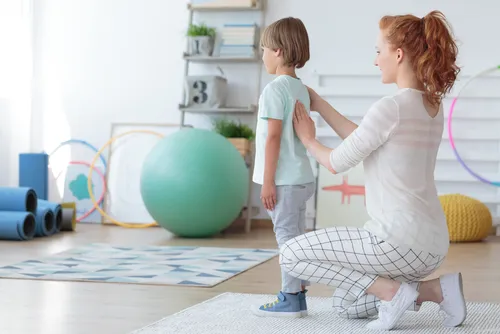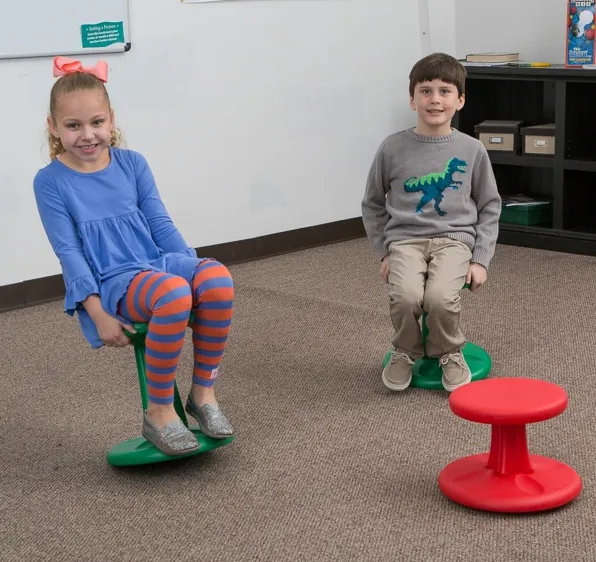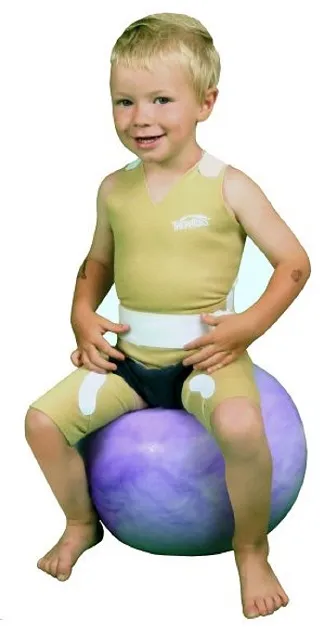 Written by Megan Smith, PT
Written by Megan Smith, PT
Posture is more than just the way you sit or stand. Defined as the overall alignment and position of the body, posture is dependent on a variety of both internal and external factors. When posture is correct, it enhances your physical and mental prowess, but when posture is poor it can cause pain, poor concentration, and even problems with breathing and digestion.
Thankfully, there are a wide variety of tips and tools that can help improve posture for your children. Whether due to a medical condition or environmental causes, there are many ways to help ensure that your child grows up with a good, strong posture that will carry them through a healthy life.

One of the best ways to help your child achieve better posture is through movement and exercise. This can take the form of free play, along with the use of structured fitness activities. Installing indoor or outdoor play equipment will encourage your children to engage and strengthen all the various muscles of their bodies.
Pediatric exercise equipment such as stationary bikes, treadmills, and elliptical trainers all come in sizes designed specifically for children, making fitness an engaging and entertaining activity. Kids rowing machines are an especially helpful tool for kids with poor posture, as they provide an awesome workout for the upper body, and strengthen the specific muscles necessary for proper support of the spine.

Active or dynamic seating options help children to move around in their seat, resulting in improved balance, stability, and core strength. Options like ball chairs are fun for kids to use, and they help increase trunk stability for better overall posture. Other active seating configurations such as T-stools and Wobble Chairs not only help youngsters to activate the muscles of their core and assist their posture, but they also help calm fidgeting, restless behavior.
Specifically designed to support good posture for various structural concerns, pediatric braces and orthotics provide comfortable, wearable postural therapy for children. They can be used for low abdominal muscle tone, giving lower torso support for kids unable to achieve strength in these areas, resulting in improved posture. Lumbar-sacral orthoses (LSO) also help young users who have poor core muscle activation, weakness, or stabilization challenges.
Specialized posture braces, such as the Soft Form Posture Control Brace, utilize compressive support to specifically stabilize the abdominal region, and help keep kids from slouching. They can be worn all day to promote proper spinal alignment.
Chairs that adapt to the user’s special positioning needs are highly useful in correcting unhealthy postures related to the child’s unique needs and conditions. Delivering a wide array of adjustment capabilities, adaptive chairs accommodate youngsters with head, pelvic, and trunk supports to keep their bodies aligned as much as possible, with added abduction or adduction when required.
Healthier posture is further enhanced with customization for legs and feet, such as with the TherAdapt Posture Chair. Specifically designed for kids with contractions of the foot and ankle, or tight hamstring muscles, this adaptive chair places the child in a secured, semi-kneeling position, inhibiting lower extremity extension and eliminating the devastating effect of these tight contractures on the pelvis while sitting.
Postural stability for children sitting on benches and other seating typically without back support can be provided with unique additions like the Kaye Posture Systems for Therapy Benches. This system includes pelvic support and a femoral stabilizer for leg abduction and positioning, along with posterior support and a wide selection of customizable options.
Children who use wheelchairs and walkers are at a heightened risk of developing poor postural habits. The disorders, disabilities, or diseases that necessitate the use of these mobility aids can cause postural challenges, as can incorrect positioning when using them.
Although walkers provide wonderful assistance and stability for ambulation, both kids and adults often develop a tendency to hunch over the walker as they walk, creating unhealthy posture. Specially designed posture walkers, like the Kaye Posture Control Walkers, offer teenagers and larger children a more upright and natural walking gait, supporting healthy posture and positioning within the “C” style frame.
Other postural walker systems provide more exacting customization benefits for certain circumstances, such as suspension conversion kits that turn regular walkers into partial weight-bearing devices. These are ideal for young children who need gait training or dynamic standing, who have not yet developed postural control, balance, or anti-gravity strength.
Wheelchair positioning tools abound for both kids and adults, and the comprehensive selection ensures everyone will be able to find the support they require for healthy posture. Posture vests help children who use wheelchairs to sit in better postures and positions comfortably, reducing fatigue, and improving respiration, allowing the trunk muscles to perform with maximum efficiency.
Great for therapists working with children on posture, posture mirrors are available in child-sized versions to better engage their smaller users. Often utilized by occupational and physical therapists, children can see themselves while performing movements, reinforcing the connection between body and mind. This encourages deeper postural training that will eventually be executed unconsciously.

Widely used and loved by therapists and healthcare practitioners, TheraTogs enable occupational and physical therapy to continue at home for children who need extra help with joint and postural alignment. Used for both children and adults living with a range of neurological conditions and postural alignment issues, TheraTogs are indicated for ataxia, hypotonia, cerebral palsy, autism spectrum behaviors, athetosis, joint laxity, in or out-toed gait, brain injury, muscle recruitment issues, and weakness and balance problems. This wearable therapy system is like having your therapist with you at all times!
Creating healthier postural habits for your children is imperative to their health and well-being. Good posture enhances both physical and mental health, allowing the body to perform all its amazing intricacies without hindrance. Developing good habits with posture now will not only help your child to live to their full potential in childhood, but also well into their adulthood.
Whether your child is able-bodied or has special needs, improvements to posture can be attained through the development of better exercise and fitness habits, positioning supports, and consistent vigilance and attention to their posture on a daily basis.
To learn more about the best tips and tricks to help both you and your child live better, healthier lives, check out the rest of our articles on special needs children and parenting at Caregiver University. And, if you're ready to compare some tools that might be helpful to you or your child, come visit Rehabmart for any and all of your therapeutic needs.

Megan has been a part of Rehabmart since its inception nearly 20 years ago. For the past several years she has been enjoying her role as HR Director while maintaining her Physical Therapy license. When she isn't working on her next in-service or working to find a new team member, she enjoys her five children, helping those who have PT type ailments, baking, practicing yoga, and working out.